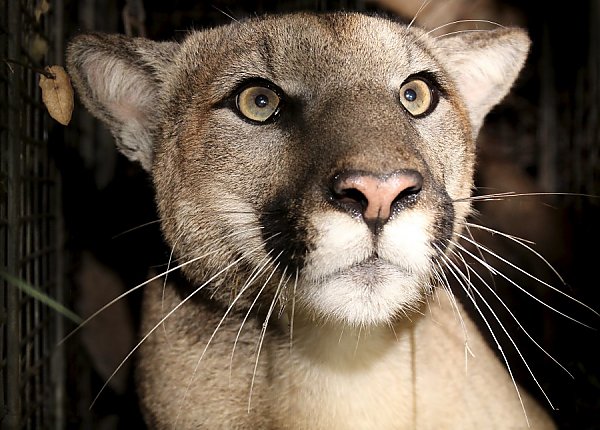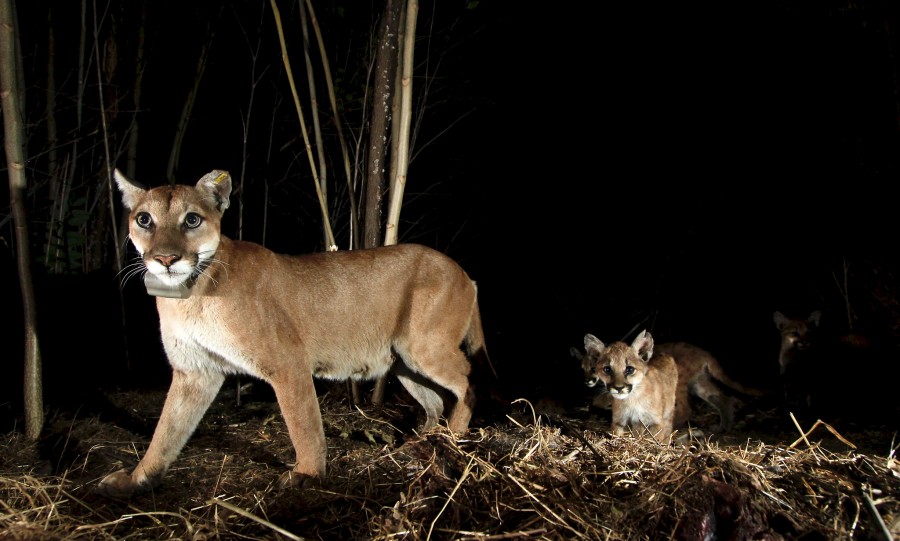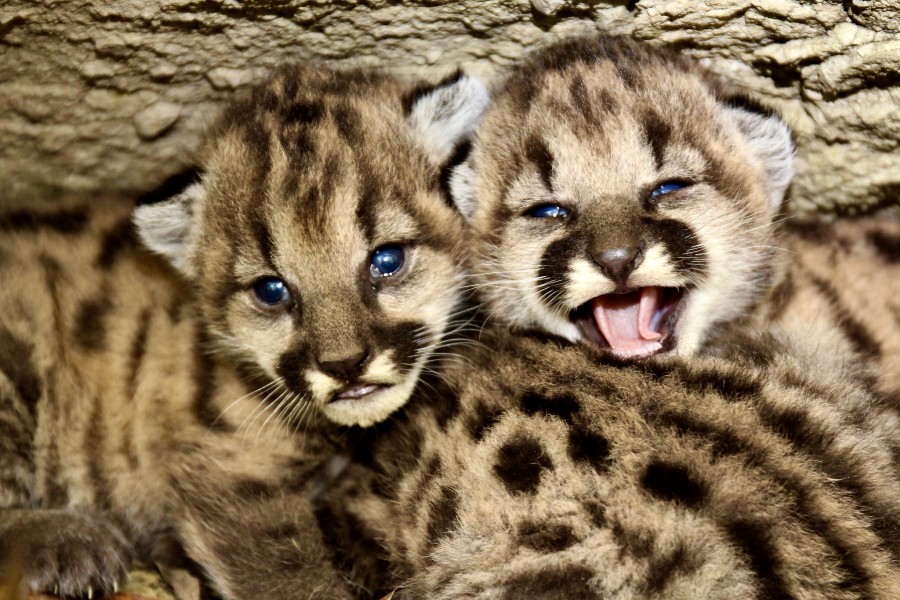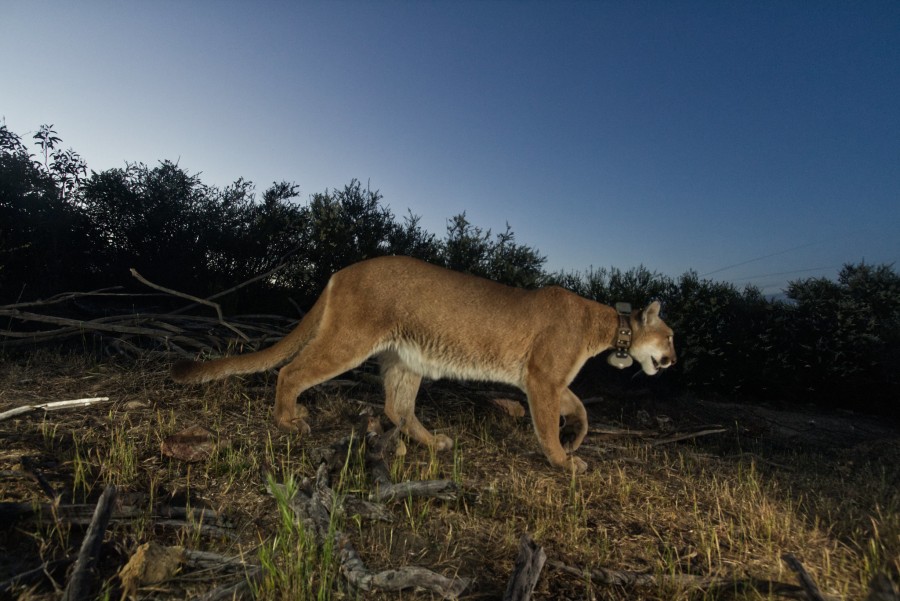Mountain Lion
Puma concolor californica
Mountain lions (also called puma, panther and catamount) are the most widely distributed cat species in the world and the largest cat species in North America. Often solitary, mountain lions have large territories of up to 100 square miles. Their conservation requires the preservation of natural habitats, making them an “umbrella species” for their range and local ecosystems. They are known for their agility, climbing abilities, and their adaptability. Their power, good climbing, and excellent jumping abilities, help them to capture large mammals such as deer, but they also feed on smaller animals, including rodents and insects, when necessary.

Credit: National Parks Service

Credit: National Parks Service

Credit: National Parks Service

Credit: National Parks Service
SPECIES IN DETAIL
Mountain Lion
Puma concolor californica
CONSERVATION STATUS: Species of Special Concern
CLIMATE CHANGE: Not Applicable
At the Aquarium
The mountain lion is illustrated on a mosaic tile mural on The Wave fountain. The fountain, mural, and accompanying graphics illustrate the story of our Los Angeles and San Gabriel Rivers. Although not on exhibit in the Aquarium, this mammal is included in our website animal database to expand on the images and information presented in The Wave fountain exhibit.
Geographic Distribution
Throughout North and South America. Abundant in British Columbia and Alberta, Canada; south through Wyoming to California, and in east and west Texas. Sparse east of the Mississippi River.
Habitat
Mountain lions can inhabit any area with adequate cover and abundant prey but they generally prefer mountains up to 3048 m (10,000 ft) elevation, swamps, tropical and subtropical forests, and semi-arid areas. Male territories average about 280 km (108 mi ), while females inhabit territories of only about 140 km (54 mi ). Males do not overlap territories with other males, but they may overlap with several females.
Physical Characteristics
Mountain lions have a large, sleek, lithe body with a relatively small head, long heavy legs and big feet with sharp, curved, retractile claws. Their skull is broad and their forehead highly arched. They are obligate carnivores with large canine teeth and sharp, specialized molars for stabbing and tearing. The short coarse fur of adults is pale brown to tawny colored above and a blend of white and buff below. The bases of their whiskers, the backs of their short rounded ears, the tip of their long tail, and the border of their pinkish colored nose are black. The spots on the coats of juveniles start to disappear when the lion is about six months old and are totally gone when it is a year old.
Size
These cats range in size from 1.5 to 2.75 m (6 to 9 ft) in length. They weigh 34 to 25 kg (75 to 275 lb). Their 53 to 92 cm (21 to 37 in) tails make up about 1/3 of the length of their bodies. Males are larger than females. The size of both species is dependent on climate, elevation, vegetation, and food supply.
Diet
These animals are top predators, preferring to eat large mammals such as white-tailed deer. They also prey on coyotes, porcupines, beavers, mice, marmots, hares, raccoons, birds, even large insects such as grasshoppers. In the north, food sources include elk, moose, and bighorn sheep. They locate prey by scent and sound. Although they sometimes lie in wait in a crouched position with tail twitching and ears upright to ambush passing prey, more often they track their prey for long distances. If tracking, they stalk to within about 9 m (30 ft) of their prey, then take two to three great running bounds, leaping on the victim’s back. Food is dragged to a safe place before it is eaten, and uneaten food is cached by covering it with sticks and leaves. Mountain lions will return to the cache repeatedly for another meal. The yearly food consumption of a single mountain lion is estimated to be 860 to 1300 kg (1896 to 2866 lb) of prey animals.
Reproduction
Although mountain lions can breed all year, males do not mate until they have established their own breeding territories. Mountain lions do not roar, but females call to males when they are ready to mate. Their mating calls often sound like loud screams. Other mountain lion vocalizations include hissing, low growls, chirps, and whistles. Breeding pairs stay together for one to about 14 days. Females will create protected maternity dens in rock shelters, caves, cervices, piles of rocks, and thickets where they line them with moss or other soft plant materials. After a gestation period of 84 to 106 days (typically 94), the female delivers 1-6 (average 2-3) cubs that are covered with blackish-brown markings. Newborns weigh about 40 gm (14 oz) and have spotted coats that begin to fade at 12 to 14 weeks. They are blind, deaf, and toothless for the about the first 10 days when their eyes open, ears unfold, first teeth erupt, and they begin to play. Their eyes, blue at birth, turn brown later. They are weaned when about 40 days old after which they begin to begin to hunt with their mothers. They remain with their moms until about 18 to 26 months old.
Behavior
Mountain lions use trees as scratching posts. They mark their territory with “scrapes”. Scrapes are formed by the lion using its hind feet to push together piles of dirt, pine needles, leaves, or other debris. After forming the scrape, they mark the pile with urine spray or, occasionally, a deposit of scat. Adult males make scrapes when courting females.
Adaptation
These animals are vocal. Because of their bone structure, they can purr but cannot roar. They use low-pitched hisses, growls, yowls, and screams depending on the circumstances. Treed or cornered, they show their alarm with a shrill piercing whistle. Females call their cubs with a similar whistle. The cubs chirp to call her. They also communicate by licking, rubbing, and touching, and smelling—all important in the bonding of the mother and cub.
The combination of rear leg muscles and optimum overall size and weight result in mountain lions having extraordinary jumping ability. While running they can take long jumps that exceed 13.7 m (45 ft). They can take vertical leaps up to 4.6 m (15 ft) which enables them to be excellent tree climbers.
Longevity
The typical life span of mountain lions in the wild is believed to be about 12 years, however, some may live 18 to 20 years in their natural habitat.
Conservation
Since 2002, National Park Service scientists have been studying mountain lions in the Santa Monica Mountains and surrounding region. This is one of the longest, continuous urban mountain lion studies. The mountain lion P-22, known as the famous mountain lion of Griffith Park, is part of this study.
California Fish and Game lists mountain lions as a species of special concern. The status of mountain lions in California has changed from “bountiful predator’ from 1907-1963 (state paid money for every lion killed) to game mammal from 1969-1990 to specially protected mammal from 1990 to the present. Under California law it is unlawful to take, injure, possess, transport, import, or sell a mountain lion or a part of it. An animal can be killed if it is a risk to people, property, pets, or livestock. The protected Florida subspecies population, P. concolor coryi, is listed as endangered. Mountain lions are also fully protected in South Dakota. Elsewhere they are classified as game animals.
At one time mountain lions roamed almost all of the lower 48 states but are now largely contained to the western states. They also ranged from northern British Columbia to southern Chile and Argentina. Today persecution, hunting, and urban sprawl have pushed them into the west, often close to highly populated areas where they can be encountered by hikers on mountain trails and sometimes enter residential developments.
Distribution
Found throughout North and South America, they once were present across the continental U.S., but are now found in only a handful of states. Abundant in British Columbia and Alberta, Canada; south through Wyoming to California, and in east and west Texas. Sparse east of the Mississippi River. A small population of genetically isolated Florida Panthers can be found in Eastern Florida.
Special Notes
The combination of rear leg muscles and optimum overall size and weight result in mountain lions having extraordinary jumping ability. While running they can take long jumps that exceed 13.7 m (45 ft). They can take vertical leaps up to 4.6 m (15 ft) which enables them to be excellent tree climbers.
The combination of rear leg muscles and optimum overall size and weight result in mountain lions having extraordinary jumping ability. While running they can take long jumps that exceed 13.7 m (45 ft). They can take vertical leaps up to 4.6 m (15 ft) which enables them to be excellent tree climbers. Mountain lions play an important role in keeping deer, rabbits, and other species populations in control, as part of a balanced ecosystem.
SPECIES IN DETAIL | Print full entry
Mountain Lion
Puma concolor californica
CONSERVATION STATUS: Species of Special Concern
CLIMATE CHANGE: Not Applicable
The mountain lion is illustrated on a mosaic tile mural on The Wave fountain. The fountain, mural, and accompanying graphics illustrate the story of our Los Angeles and San Gabriel Rivers. Although not on exhibit in the Aquarium, this mammal is included in our website animal database to expand on the images and information presented in The Wave fountain exhibit.
Throughout North and South America. Abundant in British Columbia and Alberta, Canada; south through Wyoming to California, and in east and west Texas. Sparse east of the Mississippi River.
Mountain lions can inhabit any area with adequate cover and abundant prey but they generally prefer mountains up to 3048 m (10,000 ft) elevation, swamps, tropical and subtropical forests, and semi-arid areas. Male territories average about 280 km (108 mi ), while females inhabit territories of only about 140 km (54 mi ). Males do not overlap territories with other males, but they may overlap with several females.
Mountain lions have a large, sleek, lithe body with a relatively small head, long heavy legs and big feet with sharp, curved, retractile claws. Their skull is broad and their forehead highly arched. They are obligate carnivores with large canine teeth and sharp, specialized molars for stabbing and tearing. The short coarse fur of adults is pale brown to tawny colored above and a blend of white and buff below. The bases of their whiskers, the backs of their short rounded ears, the tip of their long tail, and the border of their pinkish colored nose are black. The spots on the coats of juveniles start to disappear when the lion is about six months old and are totally gone when it is a year old.
These cats range in size from 1.5 to 2.75 m (6 to 9 ft) in length. They weigh 34 to 25 kg (75 to 275 lb). Their 53 to 92 cm (21 to 37 in) tails make up about 1/3 of the length of their bodies. Males are larger than females. The size of both species is dependent on climate, elevation, vegetation, and food supply.
These animals are top predators, preferring to eat large mammals such as white-tailed deer. They also prey on coyotes, porcupines, beavers, mice, marmots, hares, raccoons, birds, even large insects such as grasshoppers. In the north, food sources include elk, moose, and bighorn sheep. They locate prey by scent and sound. Although they sometimes lie in wait in a crouched position with tail twitching and ears upright to ambush passing prey, more often they track their prey for long distances. If tracking, they stalk to within about 9 m (30 ft) of their prey, then take two to three great running bounds, leaping on the victim’s back. Food is dragged to a safe place before it is eaten, and uneaten food is cached by covering it with sticks and leaves. Mountain lions will return to the cache repeatedly for another meal. The yearly food consumption of a single mountain lion is estimated to be 860 to 1300 kg (1896 to 2866 lb) of prey animals.
Although mountain lions can breed all year, males do not mate until they have established their own breeding territories. Mountain lions do not roar, but females call to males when they are ready to mate. Their mating calls often sound like loud screams. Other mountain lion vocalizations include hissing, low growls, chirps, and whistles. Breeding pairs stay together for one to about 14 days. Females will create protected maternity dens in rock shelters, caves, cervices, piles of rocks, and thickets where they line them with moss or other soft plant materials. After a gestation period of 84 to 106 days (typically 94), the female delivers 1-6 (average 2-3) cubs that are covered with blackish-brown markings. Newborns weigh about 40 gm (14 oz) and have spotted coats that begin to fade at 12 to 14 weeks. They are blind, deaf, and toothless for the about the first 10 days when their eyes open, ears unfold, first teeth erupt, and they begin to play. Their eyes, blue at birth, turn brown later. They are weaned when about 40 days old after which they begin to begin to hunt with their mothers. They remain with their moms until about 18 to 26 months old.
Mountain lions use trees as scratching posts. They mark their territory with “scrapes”. Scrapes are formed by the lion using its hind feet to push together piles of dirt, pine needles, leaves, or other debris. After forming the scrape, they mark the pile with urine spray or, occasionally, a deposit of scat. Adult males make scrapes when courting females.
These animals are vocal. Because of their bone structure, they can purr but cannot roar. They use low-pitched hisses, growls, yowls, and screams depending on the circumstances. Treed or cornered, they show their alarm with a shrill piercing whistle. Females call their cubs with a similar whistle. The cubs chirp to call her. They also communicate by licking, rubbing, and touching, and smelling—all important in the bonding of the mother and cub.
The combination of rear leg muscles and optimum overall size and weight result in mountain lions having extraordinary jumping ability. While running they can take long jumps that exceed 13.7 m (45 ft). They can take vertical leaps up to 4.6 m (15 ft) which enables them to be excellent tree climbers.
The typical life span of mountain lions in the wild is believed to be about 12 years, however, some may live 18 to 20 years in their natural habitat.
Since 2002, National Park Service scientists have been studying mountain lions in the Santa Monica Mountains and surrounding region. This is one of the longest, continuous urban mountain lion studies. The mountain lion P-22, known as the famous mountain lion of Griffith Park, is part of this study.
California Fish and Game lists mountain lions as a species of special concern. The status of mountain lions in California has changed from “bountiful predator’ from 1907-1963 (state paid money for every lion killed) to game mammal from 1969-1990 to specially protected mammal from 1990 to the present. Under California law it is unlawful to take, injure, possess, transport, import, or sell a mountain lion or a part of it. An animal can be killed if it is a risk to people, property, pets, or livestock. The protected Florida subspecies population, P. concolor coryi, is listed as endangered. Mountain lions are also fully protected in South Dakota. Elsewhere they are classified as game animals.
At one time mountain lions roamed almost all of the lower 48 states but are now largely contained to the western states. They also ranged from northern British Columbia to southern Chile and Argentina. Today persecution, hunting, and urban sprawl have pushed them into the west, often close to highly populated areas where they can be encountered by hikers on mountain trails and sometimes enter residential developments.
Found throughout North and South America, they once were present across the continental U.S., but are now found in only a handful of states. Abundant in British Columbia and Alberta, Canada; south through Wyoming to California, and in east and west Texas. Sparse east of the Mississippi River. A small population of genetically isolated Florida Panthers can be found in Eastern Florida.
The combination of rear leg muscles and optimum overall size and weight result in mountain lions having extraordinary jumping ability. While running they can take long jumps that exceed 13.7 m (45 ft). They can take vertical leaps up to 4.6 m (15 ft) which enables them to be excellent tree climbers.
The combination of rear leg muscles and optimum overall size and weight result in mountain lions having extraordinary jumping ability. While running they can take long jumps that exceed 13.7 m (45 ft). They can take vertical leaps up to 4.6 m (15 ft) which enables them to be excellent tree climbers. Mountain lions play an important role in keeping deer, rabbits, and other species populations in control, as part of a balanced ecosystem.

